|
Paper 21
Dancing the First Set of Quadrilles
Contributed by Paul Cooper, Research Editor
[Published - 29th March 2016, Last Changed - 27th April 2024]
The First Set of Quadrilles were the favourite Quadrille Set in London's Assembly Rooms, they were widely danced from the year 1816 forwards. We've considered them in several previous research papers, this time we'll discuss how they were danced. For further information on their historical context you can refer to The First Set, Edward Payne's First Set and James Paine's First Set. See also the 18th century Quadrille and the Quadrilles of Joseph Hart and Thomas Wilson. The First Set weren't the first Quadrilles to have ever been danced in Britain, they were however at the forefront of an invigorated interest in the dance form.
In this paper we'll review how the first set was taught by the British Regency era dancing masters. This isn't necessarily how they were danced by social dancers, but it is how many of the professional teachers intended for them to be danced. If you prefer to dance these quadrilles in a different way then that's absolutely fine. This paper attempts to describe how the Quadrilles were danced when they were introduced c.1815; as we'll see, there are significant variations between the source documents... and even more so if we consider similar works published in the 1820s. You can expect to encounter variations!
The First Set of Quadrilles (also referred to as the favourite quadrilles ) are made up of the following individual Quadrille dances:
The Major Source Works
Several early publications discuss the First Set in amplified detail. Such works do more than simply list the figures in French or English, these texts include significant additional descriptive details that can aid our understanding of the dances. They were written in response to the rising popularity of the Quadrilles, they're a testimony to the popularity of the Quadrille 200 years ago. Such works include:
The Quadrille Dancer
Edward Payne
1818 |
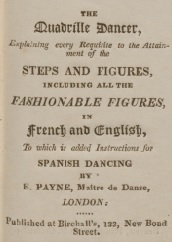
|
An advert in The Morning Post newspaper for the 11th March 1818 reported: THE QUADRILLE DANCER, just published, explaining every requisite to the attainment of the Steps and Figures, including all the Fashionable Figures in French and English. To which are added, Instructions for Spanish Dancing, - By E. PAYNE, Maitre de Danse. .
Edward Payne (1792-1819) was a London based dancing master, he is the subject of one of our previous research papers (you can follow the link to read more about him). He claimed to have been the original inventor of the quadrilles as danced in London. He was the first of the London dancing masters to publish and teach the First Set of Quadrilles c.1815, he was tremendously successful in so doing.
Payne had previously published a Quadrille Instructor in 1816 (Morning Post, 29th August 1816), this initial work briefly described his first four Sets of Quadrilles. The 1818 Quadrille Dancer extended and enhanced that work; it contained detailed instructions for many aspects of dancing Quadrilles, most notably for dancing the First Set. Payne's text is of great interest as it details how he himself taught the very first quadrille dancers in London.
This publication has an impeccable claim to authority, it is also the most detailed of the early Quadrille publications (at least until Alexander Strathy published his guide in 1822). Payne described the various quadrille steps in balletic detail, he discussed deportment and gave clear descriptions of figures that are obscure in most of our other source works. Much of what follows in this paper is derived from The Quadrille Dancer.
Payne had previously published his Quadrilles as individual Sets, perhaps from as early as 1815. Payne's first five Quadrille sets exist in more than one edition; the later editions contain some alterations compared to the earlier editions - Payne's own opinions on how the quadrilles should be danced evidently evolved over time. The figures and timing information in the Quadrille Dancer are consistent with the later editions of those publications. I've shared a c.1815 first edition of Payne's First Set here and a c.1820 Third Edition here.
|
Le Maitre a Danser
Anonymous
1818 |
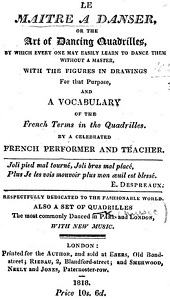
|
An advert in The Morning Post for the 1st June 1818 reported: QUADRILLES - Le MAITRE a DANSER; or, the Art of Dancing Quadrilles, by which every one may easily learn to Dance them all without a Master, with the Figures in Drawings for that purpose, and a Vocabulary of the French Terms in the Quadrilles, by a celebrated French Teacher from Paris. .
This work was printed anonymously in London in 1818, a third edition was published in 1820 (Morning Post, 4th April 1820). It contains several quotes from Jean-Étienne Despréaux's 1806 Mes Passe-Temps: Chansons suivies de L'Art de la Danse. It claimed to record an authentic style of quadrille dancing from Paris. It informs us that the English dancing masters were struggling to teach French dances and that the author was motivated to provide a correction.
It's unclear how important this work was. It was republished several times, this probably implies that it was moderately popular in London; but as we'll see, the Parisian Quadrille figures described don't precisely match those printed by the other London sources. Even the phrase Parisian Quadrilles is the cause of much confusion; when used by a British writer of the period it often refers to the Quadrille sets danced at Almack's Assembly Rooms in London, not an authentic French style of dancing from Paris. This book is a little different, when it refers to Parisian Quadrilles it literally refers to Quadrilles from Paris.
The anonymous author of this work is referred to in this paper as Maitre, rather than the more cumbersome anonymous author of the Maitre a Danser document .
The copy of this work from the British Library is available on-line courtesy of Google Books.
|
A Translation of Nine of the Most Fashionable Quadrilles
Barclay Dun
1818 |
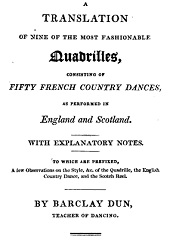
|
Dun's advert in The Scots Magazine for the 1st December 1818 reported the availability of: A Translation of Nine of the most Fashionable Quadrilles, consisting of fifty French country dances, as performed in England and Scotland, with explanatory notes, to which are prefixed a few observations on the style, &c. of the quadrille, the English country dance, and the Scots reel; by Barclay Dun, teacher of dancing. 4s .
Barclay Dun (c.1768-1847) was a Scottish Dancing Master who ran a successful business in Edinburgh. He was one of the first dancing masters to teach the Waltz in Edinburgh (Caledonian Mercury, 19th October 1811) though he is better known today for having published this late 1818 text.
The contents include several useful essays plus the English language text of the figures for some popular French Country Dances . The phrase French Country Dance was a generic term that could encompass many dance variants of a generally square form; the Quadrille, at least at this date, was simply an example of a French Country Dance. There's no suggestion that the specific dances included were literally sourced from France; they were simply popular Square dances that were already being actively danced in either London or Edinburgh.
Dun's book includes figures for the First Set, the Scottish 2nd, 3rd and 4th Sets (these are most closely associated with Nathaniel Gow but were promoted by a medley of Edinburgh's dancing masters and music shops from 1817) and of Edward Payne's 2nd through 6th sets from London (which were issued between 1816 and 1817).
Dun's version of Payne's figures often contain errors (at least for the 2nd through 6th sets of Payne's Quadrilles); it seems likely that he had interpreted Payne's figures without access to a copy of Payne's music and had to guess at the arrangement of music to dance. This makes his work less valuable than it might otherwise appear. Dun's text shows sufficient similarity to Payne's 1818 Quadrille Dancer to suggest that he probably owned a copy and derived the figures from there; Payne's Quadrille Dancer contained no music, this presumably explains the occasionally wild guesses to be found in Dun's arrangement of Payne's figures. Nonetheless, Dun's version of the First Set is sufficiently reliable to be worthy of study.
Copies of Dun's book are available on-line courtesy of Google Books and the Library of Congress.
|
The Quadrille and Cotillion Panorama
Thomas Wilson
1819, 1822 |

|
Wilson's advert in The Morning Chronicle for the 7th April 1819 reported: just published, price 4s6d, the Quadrille Panorama, part the first: the second part being now in the press will shortly be published .
The first edition of this work was published in 1819, the second edition (with additional illustrations) in 1822. We've written about it previously here, a copy of the second edition is available on-line courtesy of The Library of Congress.
We've written about Thomas Wilson (1774-1854) in numerous previous articles, he was the most prolific author of dancing manuals published during the Regency era. He had previously published his own Quadrille Instructor publication in 1816. This 1819 book discusses dancing the Quadrilles in significant detail, including useful instructions for the First Set. I don't have access to a first edition of this work so instead quote from the 1822 second edition. In so doing I'm assuming that the content is approximately as it appeared in 1819... but the 1822 text may contain later changes and clarifications.
Wilson's preferred arrangement of the First Set closely matches that of Edward Payne's first edition of the First Set, it's likely that he was influenced by Payne. Payne's later editions of the First Set adopt several modifications that are generally rejected by Wilson. Wilson characterised the major variants as being English and French; he preferred the original English arrangements but accepted that the French variants were widely danced in London.
Most of the illustrations in this paper are from the 1822 2nd edition of this book.
|
There were many other publications that also documented the First Set. These include the numerous Quadrille Preceptors (usually pocket sized guides), individual Quadrille publications (sometimes on cards and fans) and various periodicals reporting fashionable news. The source works in the table above are the earliest examples I know of that include amplified information on the First Set of Quadrilles in English, rather than providing a simple list of figures. We will include those simple figure lists as presented by both Edward Payne and James Paine in their respective First Set publications (c.1815 and 1816 respectively) as part of this analysis, but the amplified descriptions will be found to be rather more useful.
Something that will become clear is that the early publications don't agree amongst themselves on the minutiae of how these Quadrilles were danced. Minor variations are therefore inevitable on the dance floor. This is especially true if dancing later variants of the First Set of Quadrilles from the 1820s and beyond. Two additional source works that aren't discussed here, but will be of interest, are the 1827 Short Essay on the French Danse de Société by Charles Mason (which documented how Monsieur Beaupré taught Quadrille dancing in Paris, again in balletic detail); and the 1822 Elements of the Art of Dancing by Alexander Strathy (who had been teaching Quadrille dancing in Scotland from at least 1814).
The figures of the First Set are usually named in French, thereby emphasising their origin. They were also taught and called in French in many of the Assembly Rooms. The figures are named in this paper as they appear in Payne's 1818 Quadrille Dancer publication, those names do vary amongst the source works so you may encounter other variants. If you'd like to read more on the convention of calling or prompting of Quadrille dances there's an excellent paper available on the subject courtesy of dance historian Richard Powers.
It's important to understand that the choreographies of the First Set were danced to many different tunes. By the mid 1820s the First Set figures were danced almost to the exclusion of any other Quadrille figures, even in the late 1810s there were myriad Quadrille publications that were designed to be compatible with the figures of the First Set. If you attend recreations of historic balls then you will encounter these figures with unfamiliar music - 200 years ago that was both normal and expected.
Note: I refer to these quadrilles as the First Set as this is a generic term that avoids reference to a specific historic publication. Multiple musical publications were issued in London in or around the year 1816 to document these dances, their names do differ slightly across those publications. You can see five early examples in another of our papers. The 1816 publications offered a basic list of the figures of the first set without additional information; whereas this paper focuses on higher quality source documents issued around the year 1818 which build upon the basic descriptions from those earlier publications.
Steps

Figure 3. The 5 Positions
Payne described the steps for dancing Quadrilles in his book. The table below documents Payne's steps using his descriptions, in the same sequence that he listed them. It refers to the five positions . Figure 3 shows the five positions as they appear in S. J. Gardiner's 1786 A Definition of Minuet Dancing. They are the standard positions for ballet dancing and appear in numerous historic dancing texts. You can also refer to our foot positions chart.
Payne was precise in specifying the steps, we can therefore surmise that this is as he taught them at his own dancing academy. Many dancing masters wrote scornfully of the poor technique of typical Quadrille dancers, we might infer that most dancers did not dance with this degree of precision. Balletic perfection was aspirational but not necessarily achieved.
The Steps for the First Set as described by Payne:
Assemblè |
This Step is used at the end of several others, to make an Assemblé with either foot, suppose the right, pliez on your left foot, and bring the right in a circular manner to the 3rd position before, falling on both feet with the knees perfectly straight; to make one backwards, pliez in the same way, finishing with you right foot behind. This step makes but part of another, and is in general preceded by the following. |
Jettè et Assemblè |
To make a Jetté forward, spring on your left foot, at the same time raising the heel of the right perpendicular to the 5th position behind, to this add an assemblé before; to perform this step backwards, spring on your left foot, at the same time raising the heel to the right to the 3rd position before, to this add an assemblé behind.
The Jettè et Assemblè is made with the same foot, and is similar to a period or full stop in reading, that closes a sentence. In Dancing this step closes most others, upon half or a whole strain of music, it also leaves the Person equally balanced on both feet, in the 1st or 3rd position from which you are ready to commence any step, and with either foot. This step occupies one bar of time. |
Chassè Jettè et Assemblè, en avant en arrière à cotes |
To perform this Step en avant, (ie forward) with your right foot before, pliez on both feet, and rise with a half spring in the 4th position, carrying your left foot in to the place of the right, at the same time advancing the right and placing the left in the 2nd position with the knees perfectly straight. To this add the Jettè with your right foot behind, and Assemblè with the same before, this occupies two bars.
To perform this Step en arrière, (ie backwards,) pliez on both feet, and rise with a half spring, in the 4th position returning back your right foot in to the place of the left, at the same time sliding your left behind and placing the right in the 2nd position. To this add the Jettè with your left foot behind, and Assemblè with the same behind, two bars.
To perform this à droite (ie sideways to the right,) pliez on both feet, and rise with a half spring in the 2nd position carrying your left foot sideways into the place of the right, at the same time sliding your right sideways, and placing the left in the 2nd position. To this add the Jettè with your right foot behind and Assemblè with the same before, two bars.
To perform this Step à gauche (ie to the left,) you have only to reverse the feet, two bars.
The Chassè Jettè et Assemblè, en avant en arrière, is applied when you advance and retire 4 bars, it is performed twice in La Trenis, La Pastoralle, Les Graces, &c. Advancing retiring to the right and to the left, is applied in figure de l'Eté. |
Sissone Ballotè, Jettè et Assemblè |
To perform this Step from the 3rd position with the right foot before, pliez equally on both feet, and rise with a spring on your left foot, the right at the 4th position with the knee extended, balloté, bring your right to the 3rd position and return it back again to the 4th without any motion of the knee, the movement being made from your hip. To this add the Jetté with yout left foot behind and Assemblè with the same before, two bars.
When this Step is performed from the 1st position, open to the 2nd and finish the Assemblé in the 1st.
The Sissone ballotè, Jettè et Assemblè, is performed in the same place, in setting. This step added to the side chassez, is applied when you chassez croisez. |
Trois Chassés Jetté et Assemblé |
To perform this step with your right foot before, pliez on both feet, rising with a half-spring in the 4th position, sliding your left foot into the place of the right, at the same time advancing your right, and carrying the left to the 4th position before, then sink on both feet as before, rising with a half-spring in the 4th position sliding your right foot into the place of the left, at the same time advancing your left and carrying the right to the 4th position before, repeat the same as explained with the right foot, finishing in the 2nd position instead of the 4th. To this add the Jetté, with your right foot behind, and assemblé with the same before, four bars.
This step is one of the most useful and general in Quadrilles, it is applied when you demie chaine, or chaine anglaise, demie promenade, traversez tour de mains, &c.
|
Balancé |
To perform this step, pliez equally on both feet in the 1st position, and make a step forward with your right foot, rising on the toes, to the 4th position, the left following straight to the right; then sink as before, and make a step backwards with your left foot, rising on the toes to the 4th position, rising on the toes to the 4th position the right following, and finishing in the 1st position the same as at the commencement, two bars.
The balancé is in general united to the sissone balloté, Jetté et assemblé, and is applied when you balance à vos dames, &c..
|
Deux Jettés à cotes |
To perform this step, make two springs on your right foot, in the 2nd position at the same time rising the heel of the left to the 5th position behind, afterwards spring twice on your left foot in the 2nd position at the same time raising the heel of the right, to the 5th position behind. This step is applied twice over and occupies four bars, in la Poule, when you balancè quatre forming a line, also in le Moulinet, when you balancé huit, observing always to commence the Jetté, on the same side as your partner.
|
Pas de Zephyr |
To perform this step with the right foot behind, in the 4th position sink on your left foot, at the same time making an opening, or half circle with the right, to the 4th position behind, rising with a gentle spring on your left, at the same time making a half circle with the right, to the 4th position before, then bound forward on your right foot, with the knees perfectly extended, and make a battment with the left, finishing in the 4th position off the floor, repeat the same with the left foot before, to this add two Jettés on your right foot, two on the left, one on your right, one on the left, and finish with a Jetté et assemblé.
This step is applied when you advance, huit measures, tout seul, in la Pastoralle, and occupies eight bars, four advancing, and four retiring.
|
The other sources don't entirely concur with this list of steps. The author of Le Maitre A Danser wrote that With only two steps the Quadrilles may strictly be danced, viz. one to go En avant and the other for Rigaudon, Balloté, & Balancé, all others might be composed of these two .
Wilson encouraged many different step sequences to be used for figures in which Payne specified a single step. For example, Wilson wrote of the Balancez: Some persons imagine, that when Balancez is named, they must Set with the Step called the "Balancez," this is not the case; for, although the Balancez is a very suitable setting Step, yet there are others equally proper: as the "Coupé Baloté, the Sissonne Baloté," the "Rigadoon," &c. which all come under the general head, Balancez. Other similar examples could be provided. He listed the steps used in Quadrilles as Sissone Baloté, Coupé Baloté, Balancez, Rigadoon, Emboittés, Chassé, Jetté, Assemblé, Glissade, Pas de Basqué .
Payne also published an arrangement of music for dancing the First Set in Waltz rhythm c.1816. His Six New Favorite Waltzes were named for the dances of the First Set and arranged so as to be compatible with the quadrille figures. The steps employed by anyone dancing to this music must necessarily have been adapted to the waltz rhythm of the music, this suggests that Payne was comfortable with alternative steps being danced.
We do have a Steps page here at RegencyDances.org that documents (with videos) some of the more important steps for Regency era dancing. If you're interested in learning more about the steps, Alexander Strathy's 1822 Elements of the Art of Dancing is essential reading, as is the 1817 Elements and Principles of the Art of Dancing by V.G.. We've also written about Country Dancing steps in a previous article.
The Figures of Le Pantalon
The first Quadrille of the First Set is named Pantalon. We've animated it here. Pantalon can also be seen being danced in a Jane Austen Dancers of Bath video on YouTube. The figures take 32 bars to dance and are danced through twice, once for the head couples and then again for the side couples (assuming the typical 8 dancer arrangement). The major sources generally agree with each other in describing how this Quadrille is danced.
The music can be arranged as four 8 bar strains and are played as: A,BCDA,BCDA (arrangements with fewer strains are common). The leading A strain is an introduction in which the couples honour each other with bows and curtseys, the dancing begins with the B strain.
Payne wrote the following of the music: A tune for this figure requires thirty two bars, including the first repeat of the 1st part, a tune of three parts, each played as thus, the 1st part once, the 2nd ditto once, repeat the 1st part, then play the 3rd and finish with the 1st part, the tune played twice through . He arranged it as a Rondo: A,BACA,BACA. On the second repetition the side couples take their turn to perform the figures.
Payne described the figures as follows in The Quadrille Dancer; the 1st Ed figures are as they were described in Payne's first edition of his First Set, the Paine figures are as they were described in James Paine's 1816 First Set; (the images are from Wilson and may not show the figures exactly as Payne described them):
Introduction
8 bars - A | | |
Chaine Anglaise entiére
8 bars - B
1st Ed - Chaine Anglaise
Paine - La Chaine Anglaise |
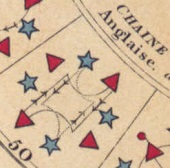
|
Payne: The four opposite advance with trois chassés Jetté et assemblé, and change situations, in passing the gentlemen give their right hands to the opposite ladies, and the left to their partners. To return, the four opposite advance as before, the gentlemen in repassing, give their right hands to the opposite ladies and the left to their partners, the four finishing in their places. This takes eight bars.
|
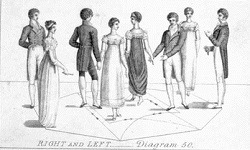 |
The other sources describe the figure in similar terms. Wilson comments The Figure shown by the Diagram is only Demie Chaine Anglaise .
Wilson shows in his diagram that the dancers should change directions when they draw level with the furthest members of the side couples, not when they reach the opposite place; the man directs the lady to pass in front of him to her opposite position thereby avoiding a sharp right angled turn. It's unclear whether Wilson's diagram should be taken literally, many modern performers prefer to include that 90 degree turn.
|
|
Balancé et tour de deux mains
8 bars - C
1st Ed - Balansés a vos Dames, Tour de mains
Paine - Balancez a vos dames, Un tour de main |
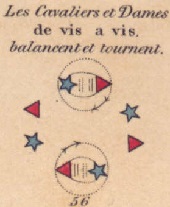
|
Payne: The two gentlemen turn to face their partners, all four balancé et sissone balloté, Jetté et assemblé, four bars. Then the two gentlemen turn their partners round to the left, four bars.
Note: the French indicates a two hand turn. The step for turning is trois chassés Jetté et assemblé.
|
The other sources describe the figure in similar terms. Maitre reports Balancez a vos dames, is when both couples opposite, dance four bars before their own partners. In Tour de main, the two gentlemen opposite give both hands to their own partners, turn round with them and remain in their places, it takes the time of four bars.
Payne is unusual (but helpful) in specifying that the turn is to the left, Wilson's diagram offers this same information. The figures of James Paine imply that the turn is with just a single hand joined, it's likely that Paine had introduced a minor error at this point in his instructions, Payne is explicit in the use of both hands. |
Chaine des Dames
8 bars - D
1st Ed - Chaine des Dames
Paine - La chaine des dames entiere |
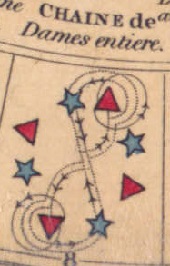
|
Payne: The two ladies pass each other in the centre, giving the right hands, the top lady turns the bottom gentleman with her left hand, while the bottom lady turns the top gentleman. The two ladies meet again in the centre, giving their right hands, the top lady turns her partner with her left hand, while the bottom lady with her partner does the same, eight bars.
Note: Payne doesn't specify a step.
|
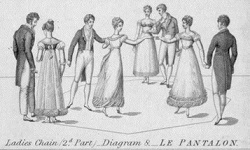
|
Dun added an additional detail by emphasising that the men should move to meet the ladies: is performed by two ladies crossing over, giving the right hand to each other, and the left to the gentleman opposite, by whom they are turned; the gentleman at the same time make two circles to the left, receiving the ladies as they come forward, and turning them fully about; the ladies then return to their respective places, giving their hands as before.
Dun's description matches Wilson's image, the two men are shown to perform a turn single figure on the spot over their left shoulders, in order to meet and turn the opposite lady; then a second time to meet and turn their own partners. It's uncertain as to whether Payne intended the men to make these little circles over their left shoulders, it's certainly possible that he did.
|
|
Demie queue du chat, or demie Promenade
4 bars - A1-4
1st Ed - Demie queue du Chat
Paine - Demie queue du Chat |
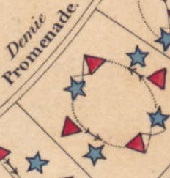
|
Payne: The two gentlemen crossing hands, takes the right and left hands of their partners, with their right and left, and change situations, moving to the right, four bars.
Note: We've discussed the promenade embrace in a previous paper. The step is the trois chassés Jetté et assemblé.
|
The other sources describe the figure in similar terms. For example, Maitre wrote The gentleman takes with his right hand his own partner's right hand, and with his left her left, both side-ways, and go ... opposite to their places . The head couples adopt a promenade hold and trace a curved cat's tail path into the opposite position. The figure ends with the head couples in the opposite place to where they started. |
Demie Chaine Anglaise
4 bars - A5-8
1st Ed - Demie chaine Anglaise
Paine - Demie chaine anglaise |

|
Payne: The four opposite return to their places, in passing the gentlemen give their right hands to the opposite ladies, and the left to their partners, four bars.
Note: The step is the trois chassés Jetté et assemblé.
|
| This is the second half of the Chaine Anglaise entiére figure from earlier in the dance, it returns the dancers to their original positions. |
Repeat once more
32 bars - BCDA | | The main figures of the dance are repeated for the side couples. |
The Figures of L'Ete
The second Quadrille of the First Set is named L'Ete, we've animated one of Payne's arrangements here. An alternative arrangement danced by the North River Colonial Dancers can be seen danced on YouTube. The figures take 24 bars to dance and are danced through four times, once for each couple (assuming the typical 8 dancer arrangement). The major sources do not precisely agree with each other in describing how this Quadrille is danced, this can add some complication for modern dancers who may have been taught differing interpretations. L'Ete is sometimes danced using further variations of the figures to any of those listed here.
Payne himself changed his tuition for these figures over time; the c.1815 first edition of his First Set featured a significantly different arrangement to that of the c.1820 third edition. Payne's 1818 Quadrille Dancer publication matches the arrangement from the the third edition. We've animated the L'Ete figures from the Quadrille Dancer here and the earlier arrangement from the first edition as part of Payne's Second Set here.
The music can be arranged as three 8 bar strains and are played as: A,BCA,BCA,BCA,BCA. The leading A strain is an introduction in which the couples honour each other, the dancing begins with the B strain.
Payne wrote the following of the music: A tune for this figure requires Twenty four bars, the tune played four times through.
Payne described the figures as follows in The Quadrille Dancer; the 1st Ed figures are as they were described in Payne's c.1815 first edition of his First Set, the 3rd Ed figures are from the c.1820 third edition of his First Set; the Paine figures are as they were described in James Paine's 1816 First Set (the images are from Wilson and may not show the figures exactly as Payne described them):
Introduction
8 bars - A | | |
En avant deux en arrière
4 bars - B1-4
1st Ed - En avant deux et en arriere
Paine - En avant deux |
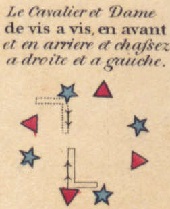
|
Payne: The 1st lady and bottom gentleman advance with Chassé Jetté et assemblé, the same back again, four bars.
|
This figure is consistent across the sources, Wilson wrote: The advancing, is a straight forward movement; and the retiring, is to return in the same line to places; two lines being given in the Diagram to show the course forward and backward. The distance for the persons to advance, is to the Centre between the Opposites. The diagram also includes the directions for the next four bars of dancing. |
Chassé à droite et à gauche
4 bars - B5-8
1st Ed - Chassés a droite et a gauche
Paine - Chassez, De chassez |

|
Payne: The lady chassés to the right and left, while the opposite gentleman does the same, four bars.
Note: The step is Chassè Jettè et Assemblè.
|
This figure is consistent across the sources, Maitre wrote: Is for the gentleman and the lady opposite to go to the right first, and then to the left; so the chassé is to go to the right and the Dechassé to the left, or to come back, but mind not to go to the left first, as some do that do not know how to perform it well, and go always facing one another . Wilson wrote that this can be performed with a Glissade step.
One of the dancers will have to pass in front of their partners, with their backs to their partners. Wilson suggests that this can be avoided by chasseing in the opposite direction, Maitre didn't approve of this innovation.
|
Traversé
4 bars - C1-4
1st Ed - Traversés (2 bars)
3rd Ed - Traversés (4 bars)
Paine - Traversez, chassez |
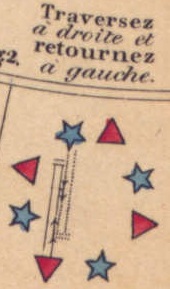
|
Payne: The lady and the gentleman cross over at the same time, and change situations, passing each other to the left, four bars.
Note: The step is Trois Chassés Jetté et Assemblé.
|
This figure is different across the sources. Both Maitre and Dun share the same figure as Payne, whereas Wilson performs this figure in just 2 bars. Wilson wrote: This Figure is frequently divided, and performed to Two Bars of Music ... which may be seen by the original Figure to L'Eté; where, after the Traversez, the Chassez to Right and Left is taken up before the other half or Retraversez. It is generally performed without the Setting, thereby making it only to take up Two Bars of the Music, the Chassez to Right and Left Four Bars, and the Retraversez, or Return to Places, Two Bars, making together Eight Bars. This alternative description also includes the activity for the rest of the eight bar phrase.
Payne's c.1815 first edition of his First Set matches the timing seen in Wilson. Wilson referred to the original Figure to L'Eté , presumably in reference to Payne's original figures. The figure in James Paine's First Set combines the traversal with half of the following figure, presumably occupying a total of four bars, as in the first edition of Payne's First Set.
Wilson's diagram shows the dancers only crossing as far as the further member of the side couples, rather than crossing into each others positions. This may be artistic license, it differs from Payne's description in which the active couple clearly end the figure in opposite places. The active couple should turn to face their home position after traversing the set. It's easier to dance the earlier variant of the figure if the traversal only extends to two-thirds of the distance than might otherwise be expected.
|
Chassé à droite et à gauche
4 bars - C5-8
1st Ed - Chassés et Dechassés (4 bars), Retournes a vos places (2 bars)
3rd Ed - Chassés et Dechassés (4 bars)
Paine - De chassez a vos places |

|
Payne: The lady and gentleman chassés to the right and left, four bars.
Note: The step is Chassè Jettè et Assemblè.
|
| This figure is a repeat of the first Chassé à droite et à gauche. It's generally consistent across the sources, though Wilson (together with Payne's c.1815 first edition of his First Set) has it start and end two bars earlier than the other writers. At the end of the figure the two active dancers end opposite their home positions.
Wilson (and the first edition of Payne's First Set) follows this figure with a two bar Retraversez, returning the dancers to their home positions - Wilson's 8 bar strain ends with the dancers in different positions to that of the other writers.
James Paine's First Set is a little more peculiar; it described the first half of the figure in the previous traversal figure and combined (as in Wilson and the first edition of Payne) the second half of the figure with a return to home positions, presumably in four bars.
|
Balancé en avant
4 bars - A1-4
1st Ed - Balansés en avant
Paine - Balancez |
|
Payne: The lady and gentleman cross over at the same time, passing each other to the left, and balancé opposite their partners, four bars.
Note: Payne has the Balancé take 2 bars, so the cross over must also take two bars. Payne's Balancé is a basic forward and backwards motion, something that could follow naturally after a crossing movement. Payne is unclear about where the dancers cross to, but with only two bars I suspect they end in front of (and thereby in Payne's words opposite ) their partners. It's perhaps significant that he didn't write retraversez , a term that implies a return back to home positions. The active couple are required to pass to the left , I suspect this means pass left shoulders which will leave them in front of their partners. The following figure will be seen to end with finishing in their places , a phrase that hints they didn't start in their places.
|
This figure is even less clear in the other sources than the preceding figure. Dun appears to be consistent with Payne, he simply wrote Cross over again, setting to partners and identified that the entire sequence takes 4 bars. Maitre could be interpreted to be consistent with Payne but appears to require an extra 4 bars of music (a 4 bar Retraversez followed by a 4 bar Balancez); this vagueness is consistent with many other sources.
Wilson, together with both the first edition of Payne's First Set and James Paine's First Set, had already returned the dancers to their home positions; their Balancez is in home positions and takes 4 bars, as in the first half of Balancé et tour de deux mains. |
Tour des deux mains
4 bars - A5-8
1st Ed - Les deux mains
Paine - un tour De main |
|
Payne: The lady joins both hands with her partners, the bottom gentleman does the same, and turn round to the left, finishing in their places, four bars.
Note: The step for turning is trois chassés Jetté et assemblé.
|
| Regardless of where the dancers ended the preceding figure, they join two hands and turn to places. This is the second half of the Balancé et tour de deux mains figure. Payne is unusual in specifying that the turn is to the left. If both couples turn to the left then one may have to travel a half turn further than the other (depending on whether they start the figure in their home positions or not), a reasonable compromise is to have the couples turn opposite directions such that the distance travelled is the same for both couples. |
Repeat three times more
72 bars - BCAx3 | | Each lady and her opposite take their turn to perform the figures. The usual sequence is for the bottom lady to lead the second iteration of the dance, then the lady to the right of the top couple, finally the lady to the left of the top couple. |
The Figures of La Poule
The third Quadrille of the First Set is named La Poule (or sometimes La Poulle ). We've animated an arrangement of Payne's version here, though as we'll see below, Payne isn't entirely clear about the figures. The animation uses what's described below as Wilson's English variant . An alternative arrangement can be seen danced at YouTube by the Vintage Dance Society.
The figures take 32 bars to dance and are danced through four times, once for each couple (assuming the typical 8 dancer arrangement). The major sources do not agree with each other in describing how this Quadrille is danced, so expect variations on the dance floor. Payne himself introduced a small change to the figures between his c.1815 first and c.1820 third editions of his First Set, we've animated the earlier arrangement as part of Payne's Second Set here.
The music can be arranged as four 8 bar strains and are played as: A,BCDA,BCDA,BCDA,BCDA (arrangements with fewer strains are common). The leading A strain is an introduction in which the couples honour each other, the dancing begins with the B strain.
Payne wrote the following of the music: A tune for this figure requires Thirty two bars, repeated the same as le Pantalon, with this exception, the Tune must be played Four times through. . He arranged it as a Rondo, A,BACA,BACA,BACA,BACA.
Payne described the figures as follows in The Quadrille Dancer; the 1st Ed figures are as they were described in Payne's first edition of his First Set, the 3rd Ed figures are from the third edition of his First Set; the Paine figures are as they were described in James Paine's 1816 First Set (the images are from Wilson and may not show the figures exactly as Payne described them):
Introduction
8 bars - A | | |
Traversent deux en donnent la main droite, balotté
4 bars - B1-4
1st Ed - Traversés deux en donnant la main droite a la dame de vis-a-vis et Sissonne Baloté
Paine - Traversez en donnant la main droite |

|
Payne: The top lady and bottom gentleman cross over at the same time and change situations, giving their right hands in passing, set, four bars.
Note: In this dance the traversé is followed by a balotté Setting step. In L'Ete the traversé took 4 bars without an explicit Setting step.
|
These four bars are generally consistent across the sources. Dun simply wrote A gentleman with the opposite lady cross over, giving the right hand, and set . It could be argued that Dun had the 1st man lead the dance, Payne was clear that the 1st lady leads. Maitre was similarly vague as was the first edition of Payne's First Set. Payne's later arrangement in the Quadrille Dancer explicitly commences with the first lady and her opposite dancing; it's likely that the later edition simply corrected a vagueness from the first edition, it wasn't a deliberate and new variation.
In this traversal the active couple should give their right hands in passing and should set on arrival (unlike the similar figure in L'Ete). This giving the right hand is sometimes performed as a graceful touching of the hands in passing. The dancers should cross the set and then turn back back into the set with sufficient time to perform a quick setting figure. The first edition of Payne's figures suggest that a balotté Setting step should be used, the other sources are unspecific such that any setting step would be reasonable.
Note that Wilson's image also includes a retraversez figure (which occupy the subsequent 4 bars of music).
|
Retraversent en donnant la main gauche
4 bars - B5-8
1st Ed - Retraversés en donnant la main gauche
Paine - Revenez a votre place par la main gauche |

|
Payne: The lady and Gentleman resume their places, giving their left hands in passing, four bars.
Note: The active couple are implied to return back to their starting positions. This time there is no explicit reference to Setting but as the same amount of time is used as in the previous figure, Setting is perhaps implied.
|
This half of the figure does vary between the sources. Payne seems clear that the dancers return to their original positions at the end of this figure (though as we'll see when we get to the next figure, it's not that simple), Wilson also requires this return to places. Maitre however offers a different detail: after the gentleman and lady opposite have given their right hands, crossing over; they give their left crossing again, and do not quit hands . Dun makes a similar statement to Maitre: Cross back again, giving the left hand, which they retain . It's not possible to retain those left hands and return to home positions (unless one has very long arms or a very small Quadrille Set).
Dun and Maitre leave the dancers in a line across the centre of the set, the active dancers still holding left hands joined; Wilson returns them to their home positions. Payne wrote that they return home but his next figure works better if they are already in the centre with left hands joined... so perhaps Payne should be interpreted as in Maitre and Dun. The lower (Wilson calls it French) of the two images for the following figure should assist in visualising the line across the set that is achieved if the left hand is not dropped.
|
Balancé quatre sans vous quitter
4 bars - C1-4
1st Ed - Les Dames donnent la main droite a leur cavaliers (2 bars), Balancés quatre sans vous quittes (4 bars)
3rd Ed - Les Dames donnent la main droite a leur cavaliers, Balancés quatre sans vous quittes (4 bars)
Paine - Balancez quatre en ligne |
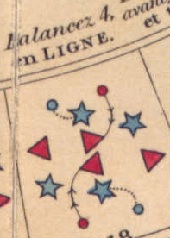
|
Payne: The lady joins her right hand with the right of her partners, the bottom gentleman with his partner does the same, the four set holding hands, forming a serpentine line, the two ladies facing to the right and the two gentlemen facing to the left, four bars.
Note: Elsewhere, Payne wrote to use the Deux Jettés à cotes step twice for the setting. In order to do that, the lead dancers should already be in a line across the set, or get themselves there almost immediately. This has implications for the interpretation of the preceding figure. The instruction that the men should face to the left and the ladies to the right is confusing, it is probably from the perspective of an observer at the top of the set (see Wilson's second diagram immediately below) rather than being relative to their current position.
|
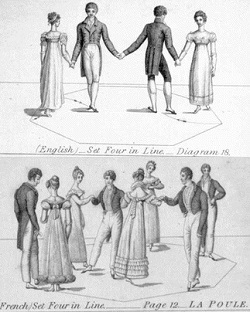 |
The different sources leave the dancers in a different starting position at the end of the preceding figure; Wilson notably starts this figure with the dancers in their original positions, he then has them move into a line of 4 with two men in the centre: This figure is formed by Two Couple making a straight Line; the Gentlemen in the Centre, and the two Ladies Outside. This Line is used in the Figure to La Poule and others, which, together with the Setting, requires Four Bars . Wilson also explained that his variant is the English style (see the upper image), he described the alternative as French (see the lower image), something he described as being a very awkward situation for the bottom Lady .
Whereas, Dun and Maitre leave one lady and one man in the centre at the end of the preceding figure. Payne could be interpreted to match either Wilson(English) or Maitre/Dun/Wilson(French); Payne's indication that the men should be facing to the left perhaps identifies him more strongly with Wilson's French variant, though the English variant could be implied if the perspective of the man is considered relative to his partner. Dun described the figure as They give the right hand to their partners, and all four set, upon a line, without quitting hands .
Payne changed his description of this figure between the first and third editions of his First Set; the c.1815 first edition is a closer match to the Wilson variant with two bars in which to take hands, four to set and two to promenade (which is the next figure that we'll come to in a moment). The c.1820 third edition has four bars to both form the line (if not already in the line at the end of the preceding figure) and set, then four to promenade; Payne's timing advice changed across the editions.
Both the sequence of dancers within the line, and their starting positions, are unclear amongst the sources. The figure ends with the dancers remaining in this serpentine (Payne) or straight (Wilson) line across the set. The two central positions are either taken by the two men (Wilson's English variant) or the lead lady and her opposite man (Wilson's French variant).
|
|
Demie Promenade
4 bars - C5-8
1st Ed - Demie queue du chat (2 bars)
3rd Ed - Demie queue du chat (4 bars)
Paine - Demie queue du chat |

|
Payne: The gentlemen still retain their partners with their right hands, and join their left with the left of their partners and half promenade, (ie change situations,) beginning round to the right, four bars.
Note: We've discussed the promenade embrace in a previous paper. The step is the trois chassés Jetté et assemblé. The outer-most dancers turn to face the same direction as the inner most dancers (regardless of gender), without dropping right hands; they then join left hands and promenade.
|
This figure is similar to the demie Promenade in Pantalon, except that the dancers start in a different position (not as shown in the image). Wilson points out that if the French variant of the preceding figures are danced, This is a very awkward situation for the bottom Lady, who must be turned by her Partner before she is in a proper Situation to perform the Half-Promenade in "La Poule," which always follows Set four in Line: this, not only breaks the Time, but requires an extra Movement by the bottom Lady; but, in the Figure shown by the Diagram (which the Author has always preferred) where the two Gentlemen come into the centre, this inconvenience is avoided, as both Couples finish in proper situations to keep up the Promenade.
In Wilson's English figure, the men are already to the left of their partners (after the outer-most dancers turn) and in a natural position to take up Promenade hold and to lead into opposite places with perhaps just two bars of music. If the French figure is used then one of the couples are in this position, the other couple has the dancers improper (the man would be to the right of the lady in the promenade embrace). The couple in improper position could take up a reversed promenade hold, but Wilson instead has the lady move around the man (with no music in which to do so) and take up a regular promenade hold. Regardless of the promenade hold used, the figure must end with the dancers in proper position and opposite their home positions. The French variant isn't symmetrical which can be confusing for the bottom most dancers, the English variant is symmetrical.
Dun simply wrote Promenade half way round . Most other writers make a similarly vague statement. The figure ends with the lead couples in opposite position and proper (the man to the left of the lady and all facing into the set).
Payne's first edition of his First Set only allowed two bars of music for the promenade; we might infer from this that he used what Wilson referred to as the English variant of the figure, this would have the bottom couple in a natural position to promenade. He had changed his opinion by the time that the third edition was published, four bars of music would become available such that the more awkwardly arranged couple could correct their odd position either upon arrival, or before setting off.
|
En avant en arrière
4 bars - D1-4
1st Ed - En avant deux
Paine -En avant deux en arriere |

|
Payne: The lady and the opposite gentleman advance and retire, (that is the lady who commenc'd with the bottom gentleman,) four bars.
Note: The step is Chassé Jetté et assemblé.
|
This figure is consistent across the sources. Dun simply wrote The couple who began advance and retire . It's the same figure as was used in L'Ete. The Wilsonian image includes an extraneous chassez to the right and left that is not part of this figure.
|
Dos-à-dos
4 bars - D5-8
1st Ed - Dos-a-dos
Paine - Dos a dos |
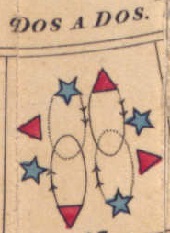
|
Payne: The lady and gentleman pass each other to the left and retire to the right, back to back, four bars. This figure is frequently performed by passing round each other, face to face, may there be termed Vis-à-vis.
|
Wilson adds the Opposites move round each other, back to back, to their original situations. In passing round each other, care must be taken to extend the Circle, to prevent the Dancers coming in contact with each other; which, amongst learners, too frequently occurs .
Maitre wrote the gentleman and the lady opposite advance crossing one another on the left side, the body always in front, then they cross behind each other to come by the right side to their places, but backwards ... But you must take care when you cross behind each other not to touch one another, as it happens to those who do not perform it well.
The Wilsonian image shows two couples performing the dos a dos , only the active couple should perform it in this dance. Payne reveals that the figure might be danced face to face, a variation that would make accidental collisions less likely to occur.
|
En avant quatre
4 bars - A1-4
1st Ed - En avant quatre
Paine -En avant quatre en arriere |
|
Payne: The two gentlemen join their right hands with their partners left, the four advance and retire, four bars.
Note: The step to use is Chassé Jetté et assemblé.
|
This figure is the same as En avant deux en arrière in L'Ete, except that four dancers are involved rather than just two and the couples hold inside hands. Dun simplifies it to Four advance and retire .
|
Demie Chaine Anglaise
4 bars - A5-8
1st Ed - Demie chaine Anglaise
Paine - Demie chaine anglaise |

|
Payne: The four cross over to their places, the gentlemen in passing give their right hands to the opposite ladies, and the left to their partners, four bars.
Note: The step is the trois chassés Jetté et assemblé.
|
| This is the same figure that was used in Pantalon. |
Repeat three times more
96 bars - BCDAx3 | | Each lady and her opposite take their turn to perform the figures. The usual sequence is for the bottom lady to lead the second iteration of the dance, then the lady to the right of the top couple, finally the lady to the left of the top couple. |
The Figures of La Trenis
The fourth Quadrille of the First Set is named La Trenis. We've animated it here. The figures take 40 bars to dance and are danced through four times, once for each couple (assuming the typical 8 dancer arrangement). The major sources largely agree with each other in describing how this Quadrille is danced, though they can be interpreted in different ways.
The music can be arranged as five 8 bar strains and are played as: A,BCDEA,BCDEA,BCDEA,BCDEA (arrangements with fewer strains are common). The leading A strain is an introduction in which the couples honour each other, the dancing begins with the B strain.
Payne wrote the following of the music: A tune for this figure requires Forty bars, repeated the same as le Pantalon, except the 3rd part, which is repeated, or must contain Sixteen bars. The tune played Four times through. He arranged it as a Rondo: A,BACCA,BACCA,BACCA,BACCA.
Payne described the figures as follows in The Quadrille Dancer; the 1st Ed figures are as they were described in Payne's first edition of his First Set; the Paine figures are as they were described in James Paine's 1816 First Set (the images are from Wilson and may not show the figures exactly as Payne described them):
Introduction
8 bars - A | | |
Chaine des dames
8 bars - B
1st Ed - Chaine des Dames
Paine - Chaine des Dames |

|
This figure is explained in Pantalon.
|
| Some interpretations like to make this a Chain for all four ladies rather than just the two leading ladies. The early sources are consistent in describing it as a Chain for just the active couples. |
Balancé à vos dames, et tour de deux mains
8 bars - C
1st Ed - Balansés a vos Dames, Tour de mains
Paine - Balancez à vos Dames, Tour de mains |

|
This figure is explained in Pantalon.
|
| The Balancé is often danced by facing partners and slipping a few steps to the right, and back to the left, similar to the Chassé à droite et à gauche in L'Ete. This common interpretation isn't consistent with Payne. Payne defines it using his forwards-and-backwards Balancé, followed by sissone balloté, Jetté et assemblé.
The other sources don't particularly comment. Maitre simply wrote both couples opposite, dance four bars before their own partners, which is always followed by Tour de main . Dun was similarly vague, he wrote Set to partners and turn them . Payne emphasised a two hand turn.
|
Un cavalier, conduit sa dame deux fois en avant, la laisse à la gauche du cavalier de vis-à-vis
8 bars - D
1st Ed - Un Cavalier avec sa Dame en avant et en àrriere, Idem en avant conduisant sa Dame a la gauche du cavalier de vis-a-vis, et Sissone Baloté
Paine - Le Cavalier conduit sa Dame en avant en arriere, La conduit a gauche du Cavalier de vis-à-vis |
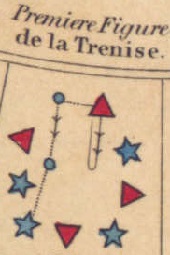
|
Payne: The gentleman with his partner advances and retires, four bars, again forward, the gentleman leaves the lady on the left of the opposite gentleman, then returns back to his place, four bars.
Note: this figure is performed with Chassè Jettè et Assemblè.
|
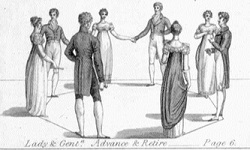 |
Wilson wrote: This figure, when performed, leaves the Lady on the opposite Situation, that is, on the Left of the opposite Gentleman, and her Partner in his original Place .
Dun wrote The first gentleman conducts his lady forward and back, then leads her across, leaves her on the left of the opposite gentleman, and returns to his place.
This is an usual figure as it leaves the dancers in an irregular position at the end of the figure. It requires subsequent figures to return the dancers back home. The first edition of Payne's figures had the man setting at the end of the figure, this was removed in the later editions. |
|
Les deux dames traversent pendant que le cavalier traverse au milieu
2 bars - E1-2
1st Ed - Les deux Dames Traversés a la place oposé pendant que le cavalier traverse au milieu
Paine - Les deux Dames traversent a la place opposée en chassant croisé, et la Cavalier traverse au milieu et Rigaudon, Et balance à sa Dame (12 bars) |

|
Payne: The two ladies cross over to the opposite places, while the gentleman pass between, two bars.
|
| Most sources describe the second part of the Trenise figure as a whole (see for example the figures of James Paine). Payne split it into several separate stages, this makes Payne's version easier to understand than most.
Dun, referring to the first two bars, wrote The first and third ladies cross over ... while they are crossing over, the first gentleman passes between them ... .
Payne has the two ladies cross into opposite places in 2 bars, perhaps like Wilson's version of the Traversé figure. The first lady will have returned to her home position and the second lady to the home position of the first man.
Wilson's diagram shows the entire 8 bars in one figure, it appears to show the ladies taking a curved path and not simply crossing the set. Payne is clear that the ladies cross into the first couples home positions.
The figure provided by James Paine is almost too vague as to be meaningful.
|
Les deux dames chassez croisez, tandis que le cavalier figure devant elles, et repassent à leur places en chassez croisez encore
6 bars - E3-8
1st Ed - Les deux Dames chassés croisés tandis que le cavalier figure devant elles et repassent a leur place respectives en chassés croisés encore |

|
Payne: The two ladies change sides, while the gentleman sets before them, two bars. The two ladies cross over back again, while the gentleman passes between and returns to his place, the two ladies again change sides, which returns the bottom lady to her place, four bars.
|
The first two bars for the ladies are described by Payne as change sides (or chassez croisez in French). The chassez croisez is a common term in quadrille dancing, it usually implies a sideways movement whilst facing forwards; it may be overly strict to require that movement in this figure however, the ladies may simply dance into each other's places.
Dun wrote of these two bars: The first and third ladies ... change sides, [the first man] sets to them . Payne's description of the 8 bar figure has caused the ladies to pass around two sides of a square (ending opposite their starting positions), while the first man moves forward and Sets. Some sources (include James Paine, see above) specify that the Setting uses a rigadon step sequence.
The remaining four bars involve the ladies crossing back to the bottom end of the set, then performing a second chassez croise to return back to their positions at the start of the 8-bar figure. This final chasse croise will involve navigating around the bottom gentleman who is stood between them.
In the 8 bars the ladies have travelled around four edges of a square. Wilson's diagram shows a shorter path through the figure. In both variants the first lady returns to her irregular position at the end of the figure.
|
La Premiére figurante que occupé la gauche du cavalier, balancé à son cav. et tour de mains
8 bars - A
1st Ed - La premiere figurante qui occupé la gauche du cavalier fait en balancés a son cavalier seulement et termine par un balancés et tour de mains
Paine - Tour de mains (4 bars) |
|
Payne: The lady who occupies the left of the gentleman, crosses over and makes a balancé to her partner, they then turn hands round to their places. Frequently the top and bottom couples balancé and turn hands, at the same time, eight bars.
Note: The step for turning is trois chassés Jetté et assemblé.
|
Payne has the first lady cross home, then balancé and turn her partner. Dun explained it slightly differently: The first couple set in the middle, then join hands and return to their places . Dun had the first couple move forward to meet each other and then return home.
Payne's version is more symmetrical: the first lady crosses home in 2 bars, the head couples balancé in 2 bars, then two hand turn in 4 bars.
|
Repeat three times more
120 bars - BCDEAx3 | | Each couple take their turn to perform the figures. The usual sequence is for the bottom couple to lead the second iteration of the dance, then the couple to the right of the top couple, finally the couple to the left of the top couple. |
The Figures of La Finale
The final Quadrille of the First Set is named La Finale. We've animated it here (Payne published different music for this Quadrille in the different editions of his First Set, the animation uses music from the c.1820 3rd edition). The figures take 32 bars to dance and are danced through four times, once for each couple (assuming the typical 8 dancer arrangement). The major sources largely agree with each other in describing how this Quadrille is danced, though it includes the entirety of the L'Ete dance and that is subject to interpretation. An alternative arrangement danced by the York Regency Dancers can be seen danced at YouTube.
The music can be arranged as four 8 bar strains and are played as: A,BCDA,BCDA,BCDA,BCDA,A (arrangements with fewer strains are common). The leading A strain is an introduction in which the couples honour each other, the dancing begins with the B strain. The introduction is sometimes omitted (or the A strain played twice), so that the dancing begins with the A strain. An additional A strain at the end allows for a final 8 bar figure to finish the dance.
Payne wrote the following of the music: A tune for this figure requires Thirty two bars, one of two parts, Eight bars, in each, or sixteen in the 2nd, played as thus, the 1st part twice, the 2nd ditto, when Eight bars and once when sixteen, and finish with the 1st part, the tune played through four times through, at the conclusion the 1st part of this tune must be played twice over. He arranged it as: A,ABBA,ABBA,ABBA,ABBA,A. It's worth noting that Payne altered the music for this Quadrille between the various editions of his First Set publication. The music in the c.1815 First edition and that in the c.1820 Third edition are quite different.
A distinguishing characteristic of the Finale is that all eight dancers move simultaneously in some of the figures, a characteristic that isn't evident in the other Quadrilles in the First Set. Thomas Wilson in his work indicated that, in his opinion, the Finale was more correctly referred to as a Cotillion than a Quadrille; that was due to this characteristic of simultaneous movement, something he considered to be unique to the Cotillion.
James Paine, in his 1816 First Set, featured a Quadrille named La Nouvelle Chasse as the finale of the set; it also embedded the figures of the L'Ete quadrille but it included moulinet figures and required an additional 8 bars of music. Paine referred to these figures as the Promenade sequence.
Payne described the figures as follows in The Quadrille Dancer; the 1st Ed figures are as they were described in Payne's first edition of his First Set (the images are from Wilson and may not show the figures exactly as Payne described them):
Introduction
8 bars - A | | |
Chassé croisé tous les huit
4 bars - B1-4
Dechassé les huits
4 bars - B5-8
1st Ed - Chassés croisés huit |
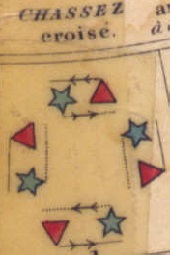
|
Payne: The whole eight change sides, the ladies pass before their partners, and set, four bars. The eight resume their places, in the same manner, four bars.
Note: This figure is performed using Sissone Ballotè, Jettè et Assemblè.
|
Dun described the Chassez Croise as All the eight chassé across and set at the corners, chassé across again and set . He adds that it is performed by one or more couples, the ladies changing places with their gentleman, and passing before them. .
Wilson wrote the Lady takes the place of the Gentleman, and the Gentleman that of the Lady .
We've previously seen chassez croisez within Payne's explanation of the Trenis figures, the variant used here includes explicit setting.
|
L'Ete
24 bars - CDA
|
|
Payne:
En avant deux en arrière. Chassé à droite et à gauche. Traversé. Chassé à droite et à gauche. Balancé et tour de mains.
The above are performed exactly the same as figure de l'Eté.
|
|
The figure of L'Ete are included within the Finale verbatim.
|
Repeat three times more
96 bars - BCDAx3 | | Each lady and her opposite take their turn to perform the same figures, beginning with a chasse croise for all eight each time. The usual sequence is for the bottom lady to lead the second iteration of the dance, then the lady to the right of the top couple, finally the lady to the left of the top couple. |
pour Finale Chassé et dechassé tous les 8
8 bars - A
1st Ed - Chassés croisés tout huit |

|
Payne: To finish, the eight change sides and back again, the same as at the commencement, which completes figure la Finale.
|
|
This is a repeat of the first chasse croise.
|
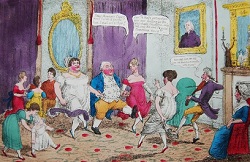
Figure 9. A Family Rehearsing a Quadrille, 1817 Courtesy of The British Museum
The Figures of La Pastoralle
The Pastoralle quadrille wasn't included in either the first or third editions of the First Set as published by Edward Payne, it was however included in the first three editions of his Second Set. It was also included in the 1816 (and confusingly named) First Set of James Paine. Payne went on to write about it in his Quadrille Dancer, but only after his description of the Finale. Some sources omit Pastoralle from the First Set, some use it to replace the Trenis Quadrille in 4th position, some include it between Trenis and Finale resulting in six Quadrilles for the First Set; Payne documented it after the Finale, perhaps in recognition of its significance despite his initial ambivalence. A document tentatively identified as Payne's 1816 Quadrille Instructor described La Pastoralle as being eligible to be admitted after the Finale of any Set of Quadrilles, this suggests that by mid-1816 Payne felt compelled to acknowledge the dance and that its role was not clearly defined.
One especially curious source document is the 1817 Quadrille Fan issued by James Paine (The Courier, 31st May 1817). This fan listed the figure sequences for the ten sets of Quadrilles that were as danced at Almacks Assembly Rooms at that date; the contents of the First Quadrille were listed as La Pantalon, L'Ete, La Poule, La Trenis, La Finale , just as Edward Payne had presented them; the La Pastorale quadrille was listed as being in the Second Quadrille. James Paine may have included La Pastorale in his own first set publication but it seems that the Almack's faithful did not consider it to be part of the first set that they danced in early 1817.
This quadrille was especially noted for its use of solo dancing passages, individuals could display their prowess (or lack thereof) to the other dancers. A passage in the New Monthly Magazine in 1821 complained of the distress this Cavalier Seul figure could cause for inexperienced and bashful dancers, this rather long passage was reprinted through the Kaleidoscope: or, Literary and Scientific Mirror (you can follow the link to read it). At least one early commentator thought such solo passages were an essential characteristic of Quadrille dancing in general and differentiated them from the older Cotillion dances. A reviewer in the 1821 3rd volume of The Quarterly Musical Magazine and Review wrote of Quadrille dancing:
Quadrilles indeed may be said to hold a middle place between the practice of the theatre and the ball-room; for while they stop short of the extreme agility and finish required in the pas seul or the pas de deux, they yet afford far greater opportunity for the display of individual art and personal grace than our country dance, or even the old French cotillion, of which the quadrille is to be considered as an extension and improvement, by the more frequent interspersion of solo or obligato parts, as a musician would say. These short and occasional presentations of each dancer to the notice of the rest, have, as it were, something of dramatic effect as well as of sentiment, without however trespassing, in the remotest degree, upon the delicacy of the private character, or pushing it to the exhibition of those qualifications which are absolutely indispensible to public performance.
The figures take either 32 or 36 bars to dance, depending on the arrangement of the music; they are danced through either four or eight times, once for each lead dancer (assuming the typical 8 dancer arrangement). We've animated a 32 bar arrangement of Pastoralle here and a 36 bar arrangement here (from Payne's Second Set). An alternative arrangement danced by the Arbeau Dancers can be seen danced at YouTube. Payne himself was confused by this dance, he included a Nouvelle Pastorale in his 1816 Fourth Set which he clearly intended to be arranged for the newer and simpler 32 arrangement, only he mistakenly provided only 28 bars of music, presumably confusing everybody else in the process!
The music can be arranged as four 8 bar strains and are played as: A,BCDA,BCDA,BCDA,BCDA,BCDA,BCDA,BCDA,BCDA (arrangements with fewer strains are likely). The leading A strain is an introduction in which the couples honour each other, the dancing begins with the B strain.
Payne wrote the following of the music: A tune for this figure requires Thirty six bars, when the hands three round is performed and thirty two when it is omitted, one of two parts, the 1st part to contain Eight bars, and the 2nd Twenty eight, or Twenty four, played as thus, the 1st part once, the 2nd ditto and finish with the 1st part, the tune played eight times through when the ladies perform the Contre-partie. He arranged it as: A,BA,BA,BA,BA,BA,BA,BA,BA.
Payne described the figures as follows in The Quadrille Dancer; the 2nd Set figures are as they were described in Payne's 1816 first edition of his Second Set of Quadrilles; the Paine figures are as they were described in James Paine's 1816 First Set (the images are from Wilson and may not show the figures exactly as Payne described them):
Introduction
8 bars - A | | |
Un cavalier avec sa dame en avant deux fois, la laisse à la gauche, du cavalier de vis-à-vis
8 bars - B
2nd Set - Un cavalier avec sa Dame en avant et en àrriere, Idem en avant conduisant sa Dame à la gauche du cavalier de vis-a-vis et Rig
Paine - Le cavalier avec sa dame, En avant Place la dame, Vis a Vis |

|
Payne: One gentleman with his partner advances, again forward, and leaves the lady on the left of the opposite gentleman and returns back to his place, eight bars.
Note: this figure is performed with Chassè Jettè et Assemblè.
|
| This is the same figure we've previously seen in La Trenise. The lead couple advance and retire, then advance again leaving the lady on the left of the opposite man.
The figures as described in Payne's Second Set call for a rig or rigadon setting step in the figure; the implication may be that the man should rigadon while the other dancers perform the next four bars of activity.
|
Le cavalier de vis-à-vis, avec les deux dames tour de rond
4 bars (optional)
2nd Set - Le cavalier de vis-a-vis Donne les mains au deux Dames et tour de rond |
|
Payne: The opposite gentleman with the two ladies hands three round to the left, four bars. This part of the figure is frequently omitted, its performance depends on the number of bars the tune contains.
|
| Payne declared this figure to be optional, Dun omitted it entirely (as did James Paine in his First Set, though he would go on to embed these extra four bars in some of his later Quadrille sets). It requires an unusual arrangement of the music that is rarely encountered.
|
Le cavalier et les deux dames en avant trois deux fois
8 bars - C
2nd Set - Le cavalier de vis-a-vis en avant et en àrriere avec les deux Dames deux fois
Paine - En avant trois Deux fois |
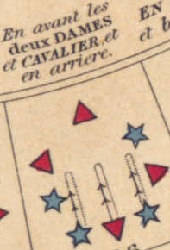
|
Payne: The gentleman and the two ladies holding hands, advances and retires twice, eight bars.
Note: this figure is performed with Chassè Jettè et Assemblè.
|
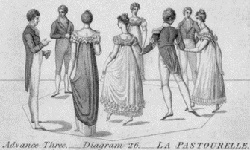 |
Dun simply wrote Three, in hands, advance and retire twice . |
|
Le Premier cavalier seul huit measures
8 bars - D
2nd Set - La Premier cavalier seul 8 mesures
Paine - Le Cavalier seul Deux fois |
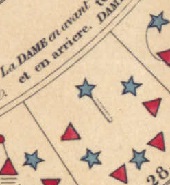
|
Payne: The first gentleman sets alone during eight bars.
Note: this figure is performed with the Pas de Zephyr.
|
This solo figure was infamous for demonstrating a dancer's skill (or lack thereof). The anonymous author of Recollections of Almacks wrote of the introduction of the Quadrille to Almack's Assembly Rooms in the following terms: Quadrilles came - Paine's first set, I remember they were called. It was ages before country gentlemen could learn them; and when they did, who was the foolhardy man who dared to show his steps in that fearful pas seul in 'La Pastorale.' .
Payne suggested a complex and fancy solo setting figure, many interpretations replace this with simpler steps such as a repeated en avant et arriere .
Wilson's illustration shows a lady's solo from later on in the dance.
|
Les quatre demie tour de rond
4 bars - A1-4
2nd Set - Les Quatres Demie tour de rond
Paine - Tour a quatre |
|
Payne: The four advance to the centre join hands and turn half round to the left and retire to the opposite places, four bars.
|
|
This figure ends with the head couples in opposite place to their home positions.
|
Demie chaine Anglaise
4 bars - A5-8
2nd Set - Demie chaine Anglaise
Paine - Demie chaine anglaise |

|
Payne: The four half right and left to their places, in passing the gentlemen give their right hands to the opposite ladies, and the left to their partners, four bars.
|
|
This is the same figure previously seen in Pantalon.
|
Repeat three times more
96/108 bars - BCDAx3 | | Each gentleman takes his turn to lead. The usual sequence is for the bottom gentleman to lead the second iteration of the dance, then the gentleman to the right of the top couple, finally the gentleman to the left of the top couple. |
Repeat four times more
128/144 bars - BCDAx4 (optional) | | Each lady takes her turn to lead, in the same sequence as with the men. Many arrangements omit these final four iterations of the dance, Payne was explicit about including them. |
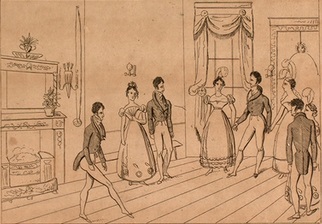
Figure 10. Cover to the Almack's Quadrilles by T. Adams, 1824 Courtesy of JScholarship
Conclusion
There is some variation between the early sources regarding the figures of the First Set. We've reviewed the amplified descriptions of the figures from four early documents, we've not considered the major documents from the 1820s and beyond; if we had done so then further variants would have been found. The modern YouTube videos demonstrate still further variants.
These quadrilles were danced for enjoyment so we hope you'll have fun recreating them. Don't worry over much about the precise stepping information; but if you feel up to it, why not give Payne's steps a chance? Better yet, why not share some videos of your dancing them for us all to enjoy and admire!
If you'd like to know more about early quadrilles, especially the First Set, I can recommend two excellent books. First, Ellis Rogers' The Quadrille, the most thorough investigation into Quadrille dancing; and also Volume 7 of John Gardiner-Garden's encyclopedic Historic Dance. As always, we live in hope that new information will be found to further our knowledge of historic dance. If you have new information or documents then please do get in touch - we'd love to speak to you.
|


 Figure 2. Ground Plan of a Quadrille, dancers stand in an octagon, 4 feet apart. From Wilson's Quadrille and Cotillion Panorama, 2nd edition, 1822.
Figure 2. Ground Plan of a Quadrille, dancers stand in an octagon, 4 feet apart. From Wilson's Quadrille and Cotillion Panorama, 2nd edition, 1822.
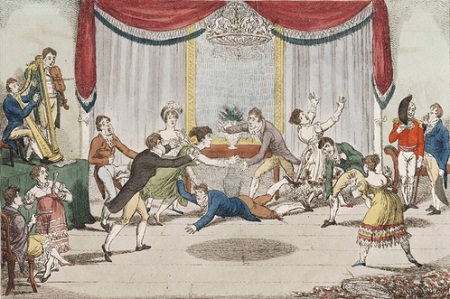 Figure 4. An Accident in Quadrille Dancing, 1817
Figure 4. An Accident in Quadrille Dancing, 1817